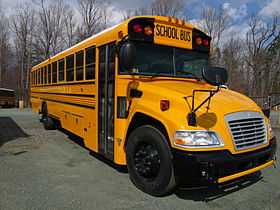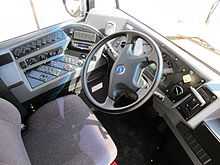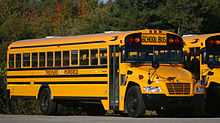Blue Bird Vision
| Blue Bird Vision | |
|---|---|
 2011 Blue Bird Vision | |
| Overview | |
| Manufacturer | Blue Bird Corporation |
| Production | 2003-present |
| Assembly |
|
| Body and chassis | |
| Body style | school bus |
| Layout | FR layout |
| Platform | Blue Bird |
| Powertrain | |
| Engine |
|
| Transmission |
|
| Dimensions | |
| Wheelbase |
|
| Length | 309–499 in (7,848.6–12,674.6 mm)[1][2] |
| Width | 96.0 in (2,438.4 mm) [1][2] |
| Height | 122–128 in (3,098.8–3,251.2 mm)[1][2] |
| Curb weight | up to 33,000 lb (14,969 kg) GVWR[1][2] |
| Chronology | |
| Predecessor |
|
The Blue Bird Vision is a Type C "conventional" school bus manufactured by Blue Bird Corporation. Built on a chassis designed and supplied in-house by the company, the Vision is available in various seating configurations and capacities ranging from 36 to 77 passengers.
First introduced in 2003, the Vision underwent a major redesign for 2008 model year and an exterior update for the 2015 model year. Coinciding with other alternative-fuel vehicles from the company, the Vision has been available with propane/LPG fuel systems as an option since 2009.
Background
In the early 2000s, Blue Bird was in the midst of trying to find a standard chassis supplier for its Blue Bird Conventional buses. In 2003, the company's 10-year supply agreement with General Motors to be the standard supplier was set to expire. The same year, Freightliner (parent company of chief competitor Thomas Built Buses) pulled its chassis supply; Navistar, marketed by Blue Bird as an alternative to GM, was parent company of IC Corporation (formerly AmTran/Ward).
In 2002, Blue Bird began development of a new generation of the Blue Bird Conventional, using a Ford F-650 medium-duty chassis. As Ford was largely left out of the full-size bus industry after 1998, the new-generation Super Duty trucks had yet to find use in school bus applications. Several Blue Bird/F-650 prototypes were built, developing several all-new features unseen on school buses; key to this was a wide-angle lens next to the entry door to increase loading-zone visibility. By the end of 2002, however, production plans for Ford-based Conventionals failed to materialize.
Although the Blue Bird/Ford never reached production, the body design of the Vision would carry over several features from the prototype. Building off Blue Bird’s purpose-built product strategy for maximum quality and optimization, the Blue Bird Vision body design includes exclusive features that directly enhance safety and durability for increased overall value. Particularly key to the Blue Bird Vision is its patented Safety View™ Vision Panel which increases the driver’s view at the lower right front loading and unloading zone. Exclusive to the Vision, the panel is made from laminated glass with a wide-angled Fresnel lens to provide a better view in this critical safety area.
Design History
2003-2007
The first-generation Vision was introduced in 2003 as the replacement for the Blue Bird Conventional/CV200 school bus, which utilized third-party chassis from Freightliner, General Motors, and Navistar International. The Vision was (and is) still unique among school bus manufacturers for using a proprietary chassis for a Type C (conventional) school bus; previously, in-house chassis were reserved for transit style school buses. As such, the Vision features a sharply angled hood for better forward visibility; no outside firms had any influence in its design.
The 2003 Vision featured a 50° wheel cut, for improved maneuverability over previous Type C buses. The instrument panel featured large back-lit gauges and switches. The Blue Bird "Handy Bus" option package specified wheelchair lifts and flat-floor interiors. The Vision was available in standard or high headroom.
From 2003 to 2005, the Vision came with the Caterpillar C7 engine as standard equipment, and in 2006, the Cummins ISB became an option.
2008-present


For the 2008 model year, Blue Bird updated the exterior body design of the Vision. The sharply angled hood was replaced with a rounded design that offered a larger grille. Instead of sourcing parts from the All American, the new Vision sourced some of its parts (headlights, steering column, instrument cluster) from Volvo trucks; in the early 2000s, Volvo was one of the parent companies of Blue Bird. Along with the traditional manual and air-powered service doors, an electric-powered service door became an option.
In 2009, the Vision became the first school bus (from the factory) to be equipped with a propane-fueled powertrain, using a GM 8.1L Vortec V8 engine. Previously, school buses fueled by propane were aftermarket conversions (typically of the Chevrolet/GMC B-Series bus chassis). Diesel-powered Visions saw the Caterpillar C7 dropped from engine lineup during 2009.
For 2011, Blue Bird made several detail changes to the Vision. On the outside, the exterior design of the rub rails were changed. On the inside, Blue Bird replaced the Volvo-sourced instrument cluster and steering column to increase parts commonality with the All American. As the supply of GM V8 engines was running out, the company switched to a Ford 6.8L V10 to keep availability of propane-fuel buses.
In 2013, a detail change saw the deletion of the Vision's namesake Safety View™ Vision Panel.
2015 update
In July 2013, Blue Bird unveiled a number of changes to the Vision at the School Transportation News Expo. Designated a 2015 model, the updated Vision is scheduled for production in October 2013.[3] While external changes to the Vision are fairly limited, updates to the lighting introduces clear-lens headlamps with integrated turn signals; the new design is meant to simplify the beam adjustment. LED clearance lights are now standard equipment. a now slightly larger blue bird logo has been placed on the hood.[3] Inside, the Vision gains a height-adjustable seatbelt for the driver's seat.[3]
To further increase the appeal of the propane-fueled Vision, Blue Bird introduced an optional 98-gallon extended-range fuel tank (standard equipment being 67 gallons).
[1][3]
The 2015 Vision comes with an optional rearview camera.
Powertrain

- Diesel
- 7.2L Caterpillar C7 (2004-2009)
- 6.7L Cummins ISB-07 I6 (2007-present)
- Propane
From its 2009 introduction to late 2012, the Vision was the only original-equipment propane-powered full-size school bus in the industry. Previously, propane-fueled school buses were second-party conversions of gasoline engines.
Comparable products
| Wikimedia Commons has media related to Blue Bird Vision. |
References
- ↑ 1.0 1.1 1.2 1.3 1.4 1.5 1.6 1.7 "2015 Blue Bird Vision Online Brochure" (PDF). Retrieved 12 August 2013.
- ↑ 2.0 2.1 2.2 2.3 2.4 2.5 "Blue Bird Vision Technical Specifications" (PDF). Retrieved 12 August 2013.
- ↑ 3.0 3.1 3.2 3.3 "Blue Bird unveils 2015 model year product enhancements at the School Transportation News Expo". Blue Bird Corporation. Retrieved 12 August 2013.
- ↑ http://www.blue-bird.com/uploadedFiles/Blue-Bird/Products/School/Vision/SB-VIS-PP-0611.pdf
- Vision School Bus Specification Sheet
- Propane Bus Spec Sheet
- Blue Bird Vision - Product Information
- Blue Bird Vision - Propane - Product Information
| ||||||||||||||||||||||||||||||||||
| ||||||||||||||||||||||||||||||||||||||||||
| ||||||||||||||||||||||||||||||||||||||||||||||||||